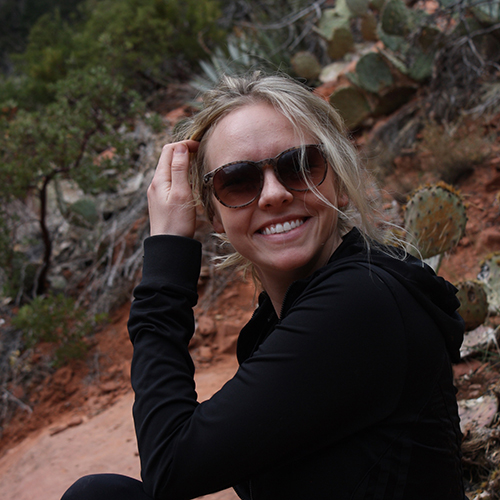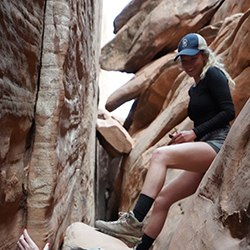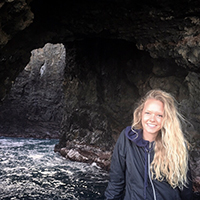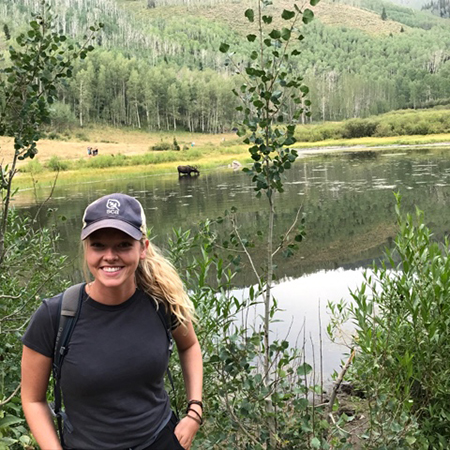Community Engagement Spotlight: Taylor Litwin
Interviewed by Brooke Larsen, Community Engagement Coordinator
Taylor Litwin is a second-year student in the UU Environmental Humanities Graduate Program. Her final project focuses on ecological restoration in Little Cottonwood Canyon, and Albion Basin specifically. For her project, she interviewed and worked with a diversity of stakeholders. After graduating this spring, Taylor will deepen her dedication and connection to Little Cottonwood Canyon as the Invasive Weeds Coordinator for the Cottonwood Canyons Foundation. In April, 2021, Brooke talked with Taylor about her project, experience with community engaged research, connection to Little Cottonwood Canyon, and future plans.
Brooke: You’re in the final month of the EH program,  congratulations! Can you talk about your final project and what role community engagement
has played in your research?
congratulations! Can you talk about your final project and what role community engagement
has played in your research?
Taylor: My project tries to answer the question 'what does ecological restoration looks like in the Anthropocene'? I focus on Albion Basin as a case study for the broad trend of overuse in protected areas. I’m looking at how we are interacting with the landscape as visitors and as recreators and how our impact is manifesting. A range of detrimental environmental issues occurring at Albion Basin is being amplified by increased visitation. With limited personnel and resources, nonprofits, the Forest Service, and other groups are trying to mitigate resource damage while keeping up with other maintenance. So, the rate of degradation is, in some ways, exceeding the rate of restoration.
Community engagement played a huge role in this project. I interviewed 20 individuals
that are associated with and/or work in Little Cottonwood Canyon and specifically
Albion Basin. From those interviews, I drew several themes of the issues that are
happening and the restoration efforts that are offsetting those issues. I honed in
on two central components of restoration: stewardship and education. Both of those
complement one  another and make for a more solid foundation of restoration moving forward. I focus
on a few hands-on efforts such as tree planting and invasive species removal, as well
as education initiatives such as the Wasatch Wildflower Festival. My project mainly highlights the efforts of Friends of Alta, Cottonwood Canyons Foundation, and Alta Environmental Center—three groups who have a history of collaboration with specific restoration efforts.
I also spoke with various board members and founding members of organizations, residents,
a couple of people who grew up in Salt Lake, former interns, several people with the
Forest Service, the Town of Alta, the Central Wasatch Commission, Carl Fisher at Save Our Canyons, and Ian Peisner, an EH graduate at Tree Utah.
another and make for a more solid foundation of restoration moving forward. I focus
on a few hands-on efforts such as tree planting and invasive species removal, as well
as education initiatives such as the Wasatch Wildflower Festival. My project mainly highlights the efforts of Friends of Alta, Cottonwood Canyons Foundation, and Alta Environmental Center—three groups who have a history of collaboration with specific restoration efforts.
I also spoke with various board members and founding members of organizations, residents,
a couple of people who grew up in Salt Lake, former interns, several people with the
Forest Service, the Town of Alta, the Central Wasatch Commission, Carl Fisher at Save Our Canyons, and Ian Peisner, an EH graduate at Tree Utah.
Brooke: What have you learned by doing community-engaged research?
Taylor: Little Cottonwood Canyon is a patchwork of landowners and land managers so
naturally there's going to be some discrepancies in how people want that land to be
managed, but even so, it was evident throughout my interviews that people really care
about the decisions being made, and that they're made thoughtfully. I think through
talking to these people rather than just reading about the place, I have a much better
grasp of where people's passions lie, what brought them to this place, what made them
stay, and what their hopes are for the future.
Having lived in Utah for only two years, I initially felt over my head in this project. At the same time, coming in as an outsider looking in has given me a clean slate to listen to all these different people who have a connection to Little Cottonwood Canyon and have cultivated and fostered that connection for decades.
Something that sticks with me is an interview I did with Jen Clancy, Deputy Town Clerk from the Town of Alta. She said to me, ‘A lot of people throughout the years have wanted to interview us and express interest in the canyon or Albion Basin and better understanding it, but then they move away or we never actually get to see how our words were used or the finished product of their work.’ She probably wasn't the only one - I felt the need to clarify that I'm dedicated to continuing this work, and I think Jen spoke for many stakeholders that have this deep connection, which for me was an important reminder. If they're giving me their time and energy, I hope at least I can give back in terms of stewardship and contributing to a positive impact rather than a negative, transient one.
At the same time, Jen and nearly everyone else I interviewed reiterated, ‘If you have any more questions, let me know.’ Multiple people shared with me reports and spreadsheets that addressed missing pieces of the puzzle I was trying to find. Even last week I sent a couple of emails, asking about the germination rate of trees that had been planted, and Beth at the Alta Environmental Center sent me the most detailed email with embedded graphs and statistics. She, just like everyone, has been a tremendous resource.
Lastly, an important part of this project was reciprocal conversation throughout an interview, so not only hearing an answer and then moving to the next question, but I tried to relate to some of the ecological processes even if I didn't have the deepest understanding of this place yet. I think that was helpful for them to realize that I do care - I'm processing what they're saying, and I'm synthesizing it into my research.

Brooke: What led you to focus on Little Cottonwood Canyon? How did you choose the stakeholders and organizations you engaged with?
Taylor: I took a sustainability class for the Interdisciplinary Graduate Certificate in Sustainability with Meghan Dovick, and it really shaped my project. That particular semester, we had funding from the Alta Environmental Center to carry out a community-engaged project. Before the development of our class project, guest speakers from the organizations I've men
tioned came in and spoke to us about different efforts in Little Cottonwood Canyon. I just kept thinking, there's a ton of people that are working here; I don't know this place yet but given that this entire semester in this class is dedicated to making Little Cottonwood Canyon more sustainable, it seems like an important task. I had a spreadsheet from the class of contacts that came to speak with us, and I had already talked with them after class and gotten to know them a little bit, so when I reached out to them for this project, it was a little bit easier because I could just say, 'Oh, I met yo
u in my class, and I was hoping to talk with you further about this work.' At the same time, I took the EH writing seminar and ended up writing two journalism-style articles. One of them was about congestion in Little Cottonwood Canyon, and one addressed Albion Basin specifically. When it came time to choose a thesis topic, it made sense, because I already had the connections established with Little Cottonwood Canyon and I narrowed my focus to Albion Basin after consulting with my committee.
Brooke: How has the EH program supported you in doing
community-engaged research?
Taylor: When I came to talk to Jeff McCarthy, Director of the program, I wasn't totally sure what I envisioned for my thesis. I knew my research interests involved a blend of environmental education, nonprofit work, and ecological fieldwork— and that’s ultimately
what came to fruition with this project. EH definitely encourages exploration within a number of disciplines. Early on, I took an interest in the sustainability certificate and I had a little bit of leeway to incorporate outside coursework, so I took a couple Parks, Recreation & Tourism classes and a nonprofit public administration class. Basically, it just amounted to a more well-rounded an
d fitting program for me based on my interests. And it was totally doable. I didn't experience any pushback or resistance to that idea. I found a niche with sustainability and science communication that worked for me. And most, if not all, of the professors I’ve taken have said, ‘write about what interests you using the tools that this class provides.’ So that allows everyone to approach assignments from a different angle within the parameters of the class and the program. I have so many good things to say: I was able to stick with what I was passionate about and at the same time challenge myself by being exposed to a variety of different disciplines within the humanities.
Brooke: After you graduate, you’re starting a position as the Invasive Weeds Coordinator for the Cottonwood Canyons Foundation. What are you looking forward to with your new position?
Taylor: The efforts I'm writing about are the efforts I'm actually going to be involved with soon, which feels good. I've done this type of plant work in the past, but without the background of knowing what the place means to people through interviews. Before coming to EH, I was living in Moab as a Vegetation Monitoring and Restoration intern, which aligns a bit with what I'll be doing here. But I didn't have as thorough of an understanding of the social, cultural and ecological importance of the places I was working in. So I think that gives the work more weight, in a good way. I know what this work means for the future of a place that a lot of people care about. And this position definitely came to fruition through community engagement because I interviewed the stewardship director, Cody Ross, for Cottonwood Canyons Foundation. Knowing that the connection was made through this project is gratifying.
I’m excited to be working with other people who want to learn  so much more about vegetation and invasive species. I was hoping for an outdoor job,
but also something that moved me forward in my career path. I initially inquired about
a crew member position because the Invasive Weeds Coordinator position hadn’t opened
yet, but the timing and opportunity ultimately worked out for me to take on more of
this leadership role. It's the best of both worlds because I'm still mostly outside
with some office and GIS work, but really getting my boots on the ground. I am excited
to orient myself better to the Wasatch and the Tri-Canyon area because as much as
I can hike around and recreate, I think it's going to be helpful to get more of an
intimate lay of the land in terms of ecology and how these systems interact.
so much more about vegetation and invasive species. I was hoping for an outdoor job,
but also something that moved me forward in my career path. I initially inquired about
a crew member position because the Invasive Weeds Coordinator position hadn’t opened
yet, but the timing and opportunity ultimately worked out for me to take on more of
this leadership role. It's the best of both worlds because I'm still mostly outside
with some office and GIS work, but really getting my boots on the ground. I am excited
to orient myself better to the Wasatch and the Tri-Canyon area because as much as
I can hike around and recreate, I think it's going to be helpful to get more of an
intimate lay of the land in terms of ecology and how these systems interact.
